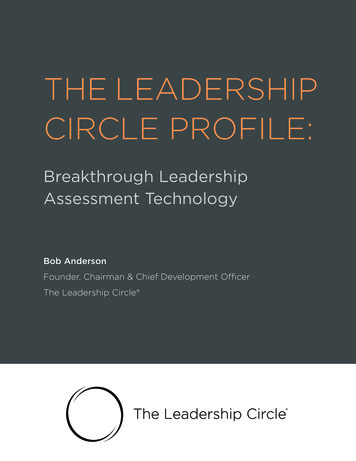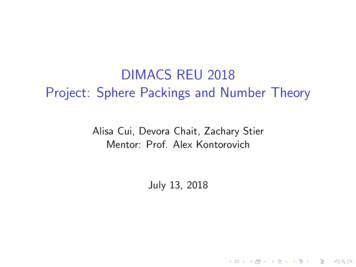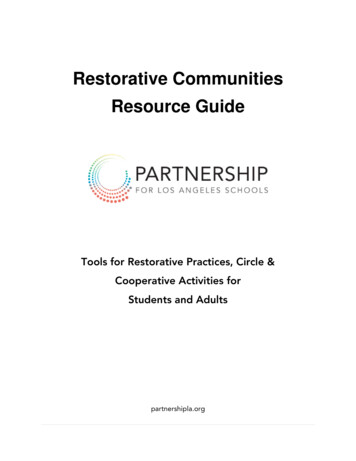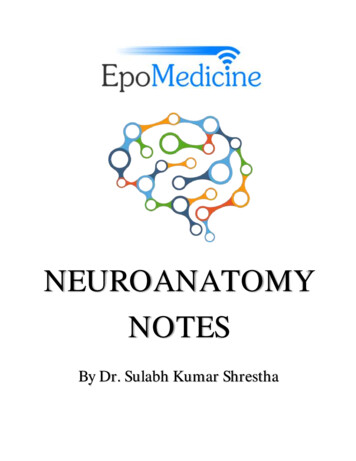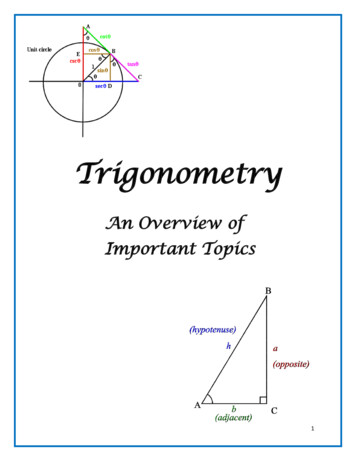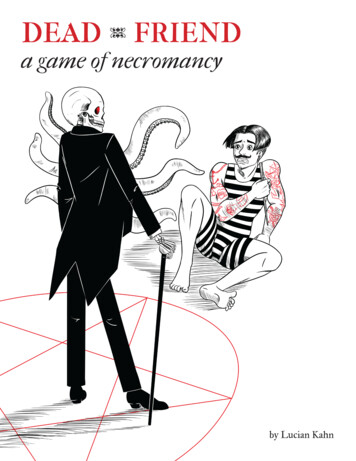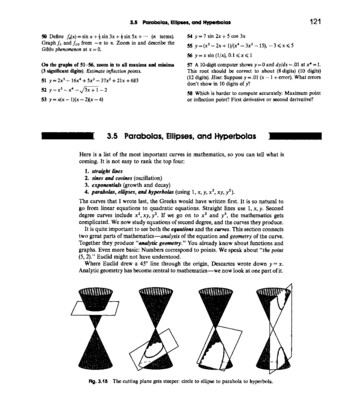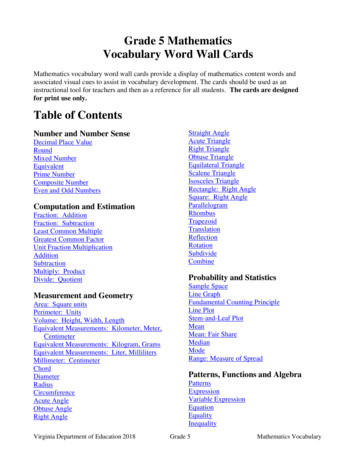
Transcription
“Within the Circle”: Space and Surveillancein Frederick Douglass’s Narrative of the Lifeof Frederick Douglass, an American SlaveFelix HaaseJena, GermanyAbstract: The detailed and chilling descriptions of physical violence inmany slave narratives often overshadow the fact that slaveholders in theAmerican South also relied on an intricate system of surveillance tocontrol and exploit their slaves. In this essay, I argue that FrederickDouglass’s first autobiography Narrative of the Life of Frederick Douglass, anAmerican Slave pictures surveillance, especially its production of space, asa central tool of slavery. The resulting spatial boundaries are investedwith metaphorical meaning and serve as an expression of Douglass’semancipation. The first part of the paper considers the plantationarchitecture and outlines how overseers, slave patrols and panopticismcreate seemingly impermeable boundaries for Douglass, which are bothof physical and psychological nature. I further demonstrate how thearchitecture of Baltimore’s city space leads to a loosening of surveillanceand allows Douglass to become literate. Finally, I draw on JurijLotmann’s theory of aesthetic space in order to analyze how spatialboundaries are crossed and metaphorical boundaries between whitenessand blackness are rendered contingent in the Narrative.In his Narrative of the Life of Frederick Douglass, an American Slave,1 FrederickDouglass often appeals directly to the reader. His autobiography is animpassioned call for the abolition of slavery and was aimed mostly at free, whitecitizens of the American North. When he talks about his attitude toward the desperatesongs of his fellow slaves, however, Douglass addresses his audience very subtly: “Iwas myself within the circle; so that I neither saw nor heard as those without might seeand hear” (27). The different interpretations of Douglass’ spatial metaphor determinewho exactly is addressed, since the circle can stand for the plantation, the South, orslavery itself. More noteworthy in this regard is Douglass’s connection between a1The text will be called Narrative throughout the paper and all quotes refer to the same edition.
Felix Haaselocation in space and its influence on perception. He urges “those without” to putthemselves into his position because his view on the world is structured by a spaceradically different from theirs. Throughout the Narrative, Douglass finds himself inhighly hierarchical and bounded spaces whose power structures influence hismovements, words, and even his gaze. There are tight regulations about who watchesand who is watched, what is visible and what is invisible, which space is open andwhich space is closed. These binarisms are created by the surveillance of Douglass’smasters and represent an obstacle to his escape and construction of identity andsubjectivity. Consequently, he expresses his struggle with slavery and his eventualemancipation through the interplay of surveillance and space.My exploration of this topic begins with an analysis of the different boundariesdescribed in the Narrative. On the plantation, they appear to be omnipresent andimpermeable, even though the number of overseers often dwarfs the number ofslaves. In order to explain this pervasiveness of plantation surveillance, I draw on thescholarly discourse on panopticism in the Narrative and discuss the importance ofBentham’s and Foucault’s concepts for the connection between surveillance and space.The first section analyzes city space and elaborates on how the social, economic, andarchitectural structures of Baltimore lead to a decrease in scrutiny and allow Douglassto take the first steps toward freedom. This analysis serves as the groundwork for thesecond section, which shows that the spatial boundaries are mirrored by metaphoricalones dividing the literary space of the Narrative. Following Jurij Lotmann’s theories, Itrace Douglass’s rhetorical way along these lines with an emphasis on his use of theChristian discourse of his former masters and on his depiction of the fight withCovey.Just as the Narrative describes Douglass’s attempts to transgress the spatialboundaries restricting his mobility, it is also itself an attempt to bridge themetaphorical boundaries of person/nonperson and whiteness/blackness. I thus arguethat the dynamics of space and surveillance on the plantation and in the city aremirrored by metaphorical boundaries in the literary space, and that Douglass’ struggleto demonstrate the personhood of black slaves is expressed through the traversal ofspatial boundaries and the deconstruction of metaphorical ones.72as peers8 (2015)
“Within the Circle”: Space and Surveillance in Frederick Douglass’s Narrative of theLife of Frederick Douglass, an American SlaveDRAWING BOUNDARIESThe Blood-Stained Gate: Plantation Space and SurveillanceThe Narrative is a text pervaded by boundaries. An analysis of their metaphoricalimportance cannot be undertaken without asking some fundamental questions first.What or who creates these boundaries, and why? How does Douglass portray them? Isthere a difference between boundaries on the plantation and in the city? Who is able tocross them? This section aims to answer these questions by connecting research on therelation between surveillance and slavery to Douglass’s autobiography and by pointingout the different surveillance methods which play a role in the construction ofboundaries. The first question I consider is a very broad one: What is the interrelationof surveillance and space?If we follow Lefebvre and his argument that space is a social product (Hallet 14),and further assume that surveillance is a social practice, then the connection betweenthe two becomes clear: Surveillance can produce space, order our perception of spaceand define the meaning we attach to it. By the same token, the power structuresinherent in a space can predetermine which surveillance methods are feasible ordesirable for the watchers—who, in regard to the plantation, can be both the mastersand the slaves. In the Narrative, the body of the slave is confronted with the spatialimplications of surveillance at every turn: Presence and absence, inside and outside,movement and rest are all dictated and controlled by a system of overseers, slavepasses and slave patrols. Douglass depicts a kind of surveillance which, as Rosenstates, serves mainly “to influence and control [.] actions through applied pressure”(234). This surveillance is based on the physical punishment of transgressions—geographical and otherwise. Douglass describes whippings, beatings, torture, executionand starvation (37-38, 47, 74). As a result, the slave and his body are subjected to“surveillance as coercion” (Rosen 245).The most important reason for the surveillance of the plantation and the rigidcircumscription of its boundaries was the efficient and unscrupulous extraction ofwork.2 In order to keep and exploit valuable slaves, the slaveholders had to constrict2There are more dimensions to surveillance than the exertion of control. Bhabha suggests that thepower derived from watching is inextricably bound with pleasure. He borrows the Lacanian termscopic drive in order to add another dimension to the surveillance of colonial subjects (76). Thesame thought is found in Bontemps, who characterizes Southern slaveholders as “observant andperceptive, [.] voyeuristic and curious” (20). In Douglass’s text, Covey seems to display anobsessive lust in observing when he “[watches] every motion of the slaves” for hours (69). In theas peers8 (2015)73
Felix Haaseand control their movements. They realized that “the mastery of human beings thrivedupon the mastery of space; that overseers oversaw both the slaves and the terrain; andthat the white regime enforced obedience not only by employing violence but byrestricting mobility and spatial privacy” (Finseth 243). Douglass emphasizes theimportance of “spatial privacy” both in terms of identity construction and resistance.The fields are a place of tight schedules and constant surveillance (25). Accordingly,field workers have little time or energy for themselves, which leads to “mentaldarkness” (85) and “the dark night” (71) of apathy. Furthermore, surveillance createsclear boundaries inside and around the plantation. One example for this is ColonelLloyd’s garden, where slaves are forbidden to enter by threat of whipping (29).Douglass also narrates the cases of a slave woman who violates her curfew and iswhipped (20-21) and a man who, after being spotted on a different plantation, ismurdered by the slaveholder with impunity (38). The fear invoked by thesepunishments works in concert with the constant threat of getting caught by “[a]ny onehaving a white face” (88) and turns the plantation into a segmented space fraught withseemingly inviolable boundaries.Rest and resistance were accessible to Douglass only on the forested outskirts ofthe plantation, which were more loosely surveilled than the center. On the one hand,this is quite simply because trees make observation difficult (Randle 113). On the otherhand, the distance to the big house and secret paths enabled the slaves to interact,reflect and rest without being watched (Vlach 231; Finseth 247). The Narrative rendersthis privacy essential to Douglass’s rebellion against Covey, because the woods enablethe former to escape undetected (74). They also provide him with rest and function asa place to meet Sandy Jenkins (76). Therefore, the woods become an in-between place:neither inside the strict surveillance of the plantation circle, nor outside of it. Theyprove that the gaze of the masters and overseers, while creating a clearly demarcatedplantation space, is not totalitarian in a literal sense.However, overt observation is only one of the surveillance methods employed inand around the plantation. Douglass is also confronted with much more subtletechniques, for example, with the spies that “[t]he slaveholders have been known tosend in [.] among their slaves, to ascertain their views and feelings in regard to theircondition. [.] If they [the slaves] have anything to say of their masters, it is generallyin their masters’ favor” (32). The slaves know they are being observed, but they do notknow when and by whom. Accordingly, they internalize “the maxim [.] that a stilltongue makes a wise head” (32) even when no actual spies are around, which meansdiscussion of plantation surveillance, the desire on the part of the slaveholders to watch theirslaves should not be disregarded.74as peers8 (2015)
“Within the Circle”: Space and Surveillance in Frederick Douglass’s Narrative of theLife of Frederick Douglass, an American Slavethat—in theory—the slaveholder can regulate the speech of his slaves wherever theyare.The power structures imposed on Douglass manifest themselves not only in hisverbal expression but also in the direction of his gaze. During the first meeting withhis new mistress, he realizes with surprise that “she did not deem it impudent orunmannerly for a slave to look her in the face” (44). This utterance is explained by thefact that there was a “protocol [.] in the colonial South governing how and when, orwhether, blacks could look at others” (Bontemps 12). Surveillance always means a gainof power on the part of the watcher. In contrast, not being able to watch or look inthe presence of others is both a practical and a symbolic degradation. It constricts theslaves’ field of vision and denies them the opportunity to return the slaveholder’s gaze,while at the same time depriving them of their autonomy and confidence. It iscertainly not an accident that Douglass learns to transcend his position as a slavethrough literacy at the same time he is allowed to ‘look up.’The regulation of both speech and gaze contributes to one of the goals ofplantation surveillance: the denial of Douglass’s and the other slaves’ subjectivity andidentity. On a practical level, this process becomes problematic for the slaveholders.How can the uniform mass of slave labor be identified once it has to leave theconfines of the plantation circle, or worse, when one of the slaves should try toescape? The Narrative indicates the slaveholders’ solution when Douglass describeshow he writes “several protections” for him and his confidantes which are meant toconvince patrols of the slave’s permission to leave the plantation (88). 3 These slavepasses were required of every slave who was found outside the limits of his plantation.Parenti writes about their importance: “The pass and the racially defined contours of(white) literacy and ([b]lack) illiteracy upon which it relied, acted as the slaveocracy’sinformation technology and infrastructure of routine surveillance” (18). Douglassinvests his literacy with the utmost importance, because by negating said binarism, itallows him to become one of the “quill-pen hackers” (Parenti 21) and enables him toescape.The slave pass system could only work with a network of dedicated controllers.These slave patrols were such a threatening image to Douglass that he hesitated toeven plan an escape and mentally projected all the obstacles he could be confrontedwith outside of the plantation: “At every gate through which we were to pass, we saw awatchman—at every ferry a guard—on every bridge a sentinel—and in every wood apatrol” (87). The totality of his hyperbole evokes the comprehensiveness of the3Interestingly enough, Douglass’s first forgery might not have helped him at all, since slave patrolstended to mistrust general passes without a specific time or date of return (Hadden 112).as peers8 (2015)75
Felix Haasesurveillance system on the plantation. Moreover, it portrays the slave patrols as anextension of plantation space outside the plantation boundaries, which is anotherexample for the way surveillance can produce space. Slave patrols were not only anobstacle to escape; they also frequently invaded the ‘personal’ space of the slaves insearch of weapons and even conducted covert surveillance around the plantation, attimes hiding in bushes (Hadden 106, 114). They were thus another instrument to drawmental and physical lines around the plantation and to grant as little privacy to theslaves as possible, which is registered in Douglass’s narration.Panoptic SurveillanceThe variety of surveillance techniques discussed so far indicates that bodily presencewas not always necessary to structure the inside and outside of the plantation. Theboundaries functioned so well because they were often deeply ingrained in the psycheof the slaves. Douglass’s treatment of this process of internalization has garneredconsiderable scholarly attention and sparked an effort to reexamine his autobiographyusing Foucault’s theories on Bentham’s concept of the Panopticon (Axelrod andAxelrod; Nielsen; Jarenski 78; Tuhkanen 96-97; Henderson 2-3). In my followingdiscussion of this connection, I draw mainly on the work of Axelrod and Axelrod aswell as Nielsen in order to gain a better understanding of the implications ofsurveillance for both the structure of plantation space and the mobility of slavestherein.Depending on the personnel and the geographical characteristics of the plantation,complete and permanent surveillance of the slaves was sometimes neither possible norefficient. One of Douglass’ slaveholders, Mr. Covey, disciplines the slaves as follows:His work went on in his absence almost as well as in his presence; and hehad the faculty of making us feel that he was ever present with us. Thishe did by surprising us. He seldom approached the spot where we wereat work openly, if he could do it secretly. He always aimed at taking us bysurprise. Such was his cunning, that we used to call him, amongourselves, “the snake.” When we were at work in the cornfield, he wouldsometimes crawl on his hands and knees to avoid detection, and all atonce he would rise nearly in our midst and scream out, “Ha, ha! Come,come! Dash on, dash on!” This being his mode of attack, it was neversafe to stop a single minute. His comings were like a thief in the night.He appeared to us to be ever at hand. He was under every tree, behindevery stump, in every bush, and at every window, on the plantation. (69)The quadripartite hyperbole at the end of the passage resembles the one mentionedearlier in Douglass’s thoughts about the slave patrols, and it has the same effect: It76as peers8 (2015)
“Within the Circle”: Space and Surveillance in Frederick Douglass’s Narrative of theLife of Frederick Douglass, an American Slaveillustrates the feeling of paranoia and anxiety that overcomes Douglass and his fellowslaves and makes them work just as hard and diligently when they are unsupervised aswhen Covey is near them. Somehow, he seems to have transcended physical space andnegated the dichotomy of presence and absence. How does Covey manage to achievethis? Firstly, the slaves appear to be on an open field; otherwise, he could not hidebehind stumps, bushes, windows or “fence-corners” (70) and be able to watch them.These objects seem to surround the place of slave labor in a way that allows him toobserve the slaves—or, more precisely—the slaves are constantly visible. Secondly,Covey himself is not visible to the slaves (Axelrod and Axelrod 119-20). Douglasscombines biblical allusions (the snake, the thief in the night) with words such as“deceiving,” “secretly,” “surprise,” and “cunning” to express and judge Covey’snonvisibility (69). The slaves only become aware of Covey’s presence when he choosesto show himself and to discipline them, either with words, or, as Douglass frequentlyexperiences, with the whip (69). The paranoia and Covey’s ‘presence-in-absence’ derivefrom the very fact that the slaves can never be sure whether they are being watchedand are unable to return his gaze (Nielsen 255). It is unknown whether Douglass hasactually read the writings of English utilitarian philosopher Jeremy Bentham, but indescribing Covey’s surveillance, he has outlined the functional principle of Bentham’sPanopticon (Nielsen 254).Bentham conceived the Panopticon in 1787 as an architectural model for prisons,hospitals, schools, and other public institutions. It comprises a circular building whichhas a tower at the center. The tower is surrounded by rows and columns of cells (orrooms, depending on the function) facing toward the inspection room at the top ofthe tower. The windows of this room are covered by venetian blinds, which allow theinspector to watch the cells and prohibits the cellmates from watching the inspector.Hence, the central purpose was “seeing without being seen” (Bentham 29). InDiscipline and Punish: The Birth of the Prison, Michel Foucault goes on to use thePanopticon as a metaphor for the modern society of discipline. He argues thatpanopticism renders power visible but unverifiable, and thus present and absent at thesame time. The use of power becomes more efficient as the number of watchersdecreases and the number of the watched increases. Furthermore, the need forphysical contact is reduced “[b]ecause [.] without any physical instrument other thanarchitecture and geometry, it acts directly on individuals, it gives ‘power of mind overmind’” (Foucault 206). The structure and implications of power need no longer beimposed directly—the panoptic gaze becomes internalized.Douglass is not the only one to note the significance of the Panopticon forplantation surveillance and architecture. Many slaveholders seem to have had thestructure in mind as they planned the layout of their plantations. They connectedas peers8 (2015)77
Felix Haasearchitecture with surveillance because “buildings mold behavior; therefore, bodies inspace become the medium through which the struggle for control takes place” (Randle105). The central buildings of plantations were often erected at “key points in thelandscape” (Friedman) from which the places of slave labor could be overseen. Eitherthe slaveholder’s mansion or the overseer’s house featured an elevated veranda orwindows that were used for surveillance and had the exact effect Bentham envisioned:seeing without being seen (Delle 152). Two concessions have to be made here. Firstly,Bentham saw the Panopticon as a humane and progressive model of discipline thatfeatured as little physical violence as necessary, which was of course not true for slaveplantations. Panopticism can thus only be seen as a contributing factor to the“geography of power” of plantation space (Randle 105), not its main organizingprinciple. Secondly, Foucault’s metaphor has undergone numerous critical revisionssince its conception. It is featured here because it can shed light on the relation ofsurveillance and space in the Narrative, not vice versa.Douglass describes the effects of Covey’s panoptic surveillance both in spatial andpsychological terms. The former is the already mentioned omnipresence of thewatcher—the whole plantation space seems to be subject to his exercise of power anddiscipline. This has an impact on Douglass’s conception of himself as an individual:My natural elasticity was crushed, my intellect languished, the dispositionto read departed, the cheerful spark that lingered about my eye died; thedark night of slavery closed in upon me, and behold a man transformedinto a brute. (71)Interestingly, Douglass uses a spatial metaphor—“closed in”—when writing about theconstricting and dehumanizing consequences of not only the never-ending labor andphysical punishments but also Covey’s tendency for deception. The metaphor evokesinevitability: Douglass is unable to resist—he has, literally, no way out—because he“internalized [.] his own powerlessness” (Axelrod and Axelrod 121). Douglassunderlines the effects of panopticism by contrasting Covey with Mr. Freeland, whomhe praises for being “open and frank” (81). The slaves “always knew where to findhim” (81). The possibility of locating and seeing the slaveholder enables countersurveillance on the part of Douglass and the slaves, which in turn destroys the powerdifferential of the Panopticon and rids space of the extreme anxiety produced byCovey.Douglass’s narration emphasizes the efficiency of panoptic surveillance andshowcases its application on the plantation. He portrays Covey’s technique asemblematic for a regime of slavery that relies on the advantage of controlling brutes,rather than autonomous human beings. Consequently, the space produced by thissurveillance has clear boundaries and rules which are inscribed into Douglass’s mind78as peers8 (2015)
“Within the Circle”: Space and Surveillance in Frederick Douglass’s Narrative of theLife of Frederick Douglass, an American Slaveand body. However, once he travels to the city, the tables turn and it is he whoinscribes the space, which has profound implications both for his identity and for therhetorical aim of his narrative.Opening the Gateway: City Space and SurveillanceDouglass’ spatial transition from the plantation to the city of Baltimore is also a fittingtransition between sections two and three of this paper, since his descriptionsilluminate the interplay of surveillance and space, while, at the same time,demonstrating his conversion of space into a metaphor. The city space necessitatesdifferent surveillance methods than the plantation, which in turn influence howDouglass perceives and negotiates his surroundings. Closed and open spaces, as well asprivacy and observation, again play major roles in the construction of his identity. Or,to be more precise: Douglass is only able to construct his own identity because he hasaccess to knowledge, and he uses the city space with its permeable borders—incontrast to the plantation—as a metaphor for this process.Even though Douglass is positively surprised when he first travels to Baltimoreand meets his new master and mistress—as evidenced by the freedom of his gaze—itdoes not take long until he registers the corrupting effects of slavery. Similar to the tarthat surrounds Colonel Lloyd’s garden and defiles the slaves, the Aulds’ power overDouglass and their subsequent wish to preserve it lead them to suppress his desire tolearn and make them place him under “[narrow]” surveillance (49). Douglass describesthis change as a fall from the heavenly state of humanity—“angelic”—to themonstrous depths of sin—“demon” (45)—a fall that is exemplified by the treatmentHenrietta and Mary receive from Mrs. Hamilton, who starves and whips them (47).The city is therefore by no means a space without repressive power structures orphysical discipline. Still, Douglass contrasts city space with the plantation on manyoccasions, specifically when it comes to surveillance methods and their dependence onthe city’s spatial characteristics.Douglass’s ability to look at his new masters in the city transforms him from amere object of their gaze to a subject capable of watching himself—in both senses ofthe expression. What has far greater implications, however, is the fact that his mastersfind themselves in a social network of gazes and are also subject to the coercion thissystem entails. While, to Douglass, the owners of the plantation seem to usurp theplace of God as the unwatched watcher, the slaveholders in the city base theirdecisions on the implied observation of others: “He is a desperate slaveholder, whowill shock the humanity of his nonslaveholding neighbors with the cries of hisas peers8 (2015)79
Felix Haaselacerated slave” (46). The mere vicinity of whites without slaves appears to establish a“vestige of decency” (46). The decency was noncommittal and in no sense permanent,but it introduces a variable in the master/slave relationship that helps Douglass in hisfuture struggle with Covey. It also leads to a “marked difference [.] in the treatmentof slaves” (46), which extends from the way they are fed to an increase in their amountof safety, privacy and mobility.These changes are not only subject to the social dimension of city space but alsoto its architectural and economical structure. The existence of “separate room[s]” (49)in the house alone creates a space where Douglass can be by himself and unobserved,a state which, on the plantation, was only accessible in the woods on the periphery. Hismasters realize the dangers of this privacy particularly after they suspect him ofattempting to become literate and try to restrict the time he spends alone (49). Thehouse itself provides a space surrounded by walls, which means on the one hand thatslaveholders can discipline their slaves in secret—as Douglass shows with Henriettaand Mary—but, on the other hand, allows the slave to escape the direct gaze of theirmasters when outside the house. Since many slaveholders in the city used their slaves torun errands, the latter could move around the city as free and unobserved as otherwhites on the street allowed them to. Douglass enjoys the same privilege as he writesabout visits to Mr. Hamilton’s house (47), the shipyard (53) and the streets ofBaltimore in general (49).For Douglass, the consequence of this mobility is twofold: It furnishes him with asocial identity and creates a spatial privacy that eventually allows him to becomeliterate. On his errands, Douglass meets and interacts with a variety of people, amongthem street urchins (49) and Irish sailors (52). His communication with the latter isanother example of his internalization of the panoptic gaze: “I pretended not to beinterested in what they said, and treated them as I if I did not understand them; for Ifeared they might be treacherous” (52-53). Nevertheless, their information strengthenshis resolve to escape. The urchins are even more important, however, in that theypresent an opportunity for human interaction outside the power structure of slavery.Douglass can talk openly to them and, for the first time in the Narrative, existsexternally as a truly social human being. Their input, which helps him to learn how toread, is only accessible because Douglass can move through the city space unobserved.Moreover, the fact that he has free time, mobility and privacy allows him to learn howto write by observing the carpenters (53) and copying letters in the safety of hismasters’ abandoned house (53-54). This relation between literacy and city space—terms which metaphorically stand for freedom and privacy, respectively—culminates inone of the central images of the Narrative: “During this time, my copy-book was theboard fence, brick wall and pavement; my pen and ink was a lump of chalk” (53).80as peers8 (2015)
“Within the Circle”: Space and Surveillance in Frederick Douglass’s Narrative of theLife of Frederick Douglass, an American SlaveAlthough Douglass means this quite literally, his words, as they so often do throughoutthe Narrative, take on a metaphorical meaning: The very space of Baltimore, asopposed to the plantation with its impenetrable barriers and panoptic surveillance,makes it possible for him to escape the gaze of his masters momentarily and becomesomething other than a mere slave—a reader.LOCATING THE INTERSECTION OF SPACE, SURVEILLANCE, AND IDENTITYIN THE NARRATIVELotmann’s Theory of Literary SpaceSo far, my analysis has shown how Douglass portrays the impact of surveillance on hislife as a slave, especially in regard to its production of space. But how can this interplayof surveillance and space contribute to an interpretation of the Narrative in a culturalcontext, let alone help to understand the rhetorical importance of his autobiography?In trying to answer this question, I will first turn to the theories of the Russianstructuralist and semiotician Jurij Lotmann, who is regarded as one of the majorinfluences in translating the implications of the ‘spatial turn’ from cultural studies toliterary studies. In Die Struktur literarischer Texte, Lotmann begins his discussion ofaesthetic space with the assertion that space is not only a general category of humanperception, but, more abstractly
n his Narrative of the Life of Frederick Douglass, an American Slave,1 Frederick Douglass often appeals directly to the reader. His autobiography is an impassioned call for the abolition of slavery and was aimed mostly at free, white citizens of the American Nor


